+ Open data
Open data
- Basic information
Basic information
| Entry |  | |||||||||||||||
|---|---|---|---|---|---|---|---|---|---|---|---|---|---|---|---|---|
| Title | Human KCNQ2-CaM in complex with HN37 | |||||||||||||||
 Map data Map data | ||||||||||||||||
 Sample Sample |
| |||||||||||||||
 Keywords Keywords |  potassium voltage-gated channel / HN37 / potassium voltage-gated channel / HN37 /  MEMBRANE PROTEIN MEMBRANE PROTEIN | |||||||||||||||
| Function / homology |  Function and homology information Function and homology informationaxon initial segment / Voltage gated Potassium channels /  node of Ranvier / Interaction between L1 and Ankyrins / node of Ranvier / Interaction between L1 and Ankyrins /  ankyrin binding / ankyrin binding /  voltage-gated potassium channel activity / voltage-gated potassium channel activity /  voltage-gated potassium channel complex / potassium ion transmembrane transport / voltage-gated potassium channel complex / potassium ion transmembrane transport /  nervous system development / chemical synaptic transmission ...axon initial segment / Voltage gated Potassium channels / nervous system development / chemical synaptic transmission ...axon initial segment / Voltage gated Potassium channels /  node of Ranvier / Interaction between L1 and Ankyrins / node of Ranvier / Interaction between L1 and Ankyrins /  ankyrin binding / ankyrin binding /  voltage-gated potassium channel activity / voltage-gated potassium channel activity /  voltage-gated potassium channel complex / potassium ion transmembrane transport / voltage-gated potassium channel complex / potassium ion transmembrane transport /  nervous system development / chemical synaptic transmission / nervous system development / chemical synaptic transmission /  calmodulin binding / calmodulin binding /  synapse / synapse /  plasma membrane plasma membraneSimilarity search - Function | |||||||||||||||
| Biological species |   Homo sapiens (human) Homo sapiens (human) | |||||||||||||||
| Method |  single particle reconstruction / single particle reconstruction /  cryo EM / Resolution: 2.5 Å cryo EM / Resolution: 2.5 Å | |||||||||||||||
 Authors Authors | Ma D / Li X / Guo J | |||||||||||||||
| Funding support |  China, 4 items China, 4 items
| |||||||||||||||
 Citation Citation |  Journal: Nat Commun / Year: 2023 Journal: Nat Commun / Year: 2023Title: Ligand activation mechanisms of human KCNQ2 channel. Authors: Demin Ma / Yueming Zheng / Xiaoxiao Li / Xiaoyu Zhou / Zhenni Yang / Yan Zhang / Long Wang / Wenbo Zhang / Jiajia Fang / Guohua Zhao / Panpan Hou / Fajun Nan / Wei Yang / Nannan Su / ...Authors: Demin Ma / Yueming Zheng / Xiaoxiao Li / Xiaoyu Zhou / Zhenni Yang / Yan Zhang / Long Wang / Wenbo Zhang / Jiajia Fang / Guohua Zhao / Panpan Hou / Fajun Nan / Wei Yang / Nannan Su / Zhaobing Gao / Jiangtao Guo /  Abstract: The human voltage-gated potassium channel KCNQ2/KCNQ3 carries the neuronal M-current, which helps to stabilize the membrane potential. KCNQ2 can be activated by analgesics and antiepileptic drugs but ...The human voltage-gated potassium channel KCNQ2/KCNQ3 carries the neuronal M-current, which helps to stabilize the membrane potential. KCNQ2 can be activated by analgesics and antiepileptic drugs but their activation mechanisms remain unclear. Here we report cryo-electron microscopy (cryo-EM) structures of human KCNQ2-CaM in complex with three activators, namely the antiepileptic drug cannabidiol (CBD), the lipid phosphatidylinositol 4,5-bisphosphate (PIP), and HN37 (pynegabine), an antiepileptic drug in the clinical trial, in an either closed or open conformation. The activator-bound structures, along with electrophysiology analyses, reveal the binding modes of two CBD, one PIP, and two HN37 molecules in each KCNQ2 subunit, and elucidate their activation mechanisms on the KCNQ2 channel. These structures may guide the development of antiepileptic drugs and analgesics that target KCNQ2. | |||||||||||||||
| History |
|
- Structure visualization
Structure visualization
| Supplemental images |
|---|
- Downloads & links
Downloads & links
-EMDB archive
| Map data |  emd_35877.map.gz emd_35877.map.gz | 49.1 MB |  EMDB map data format EMDB map data format | |
|---|---|---|---|---|
| Header (meta data) |  emd-35877-v30.xml emd-35877-v30.xml emd-35877.xml emd-35877.xml | 15.2 KB 15.2 KB | Display Display |  EMDB header EMDB header |
| Images |  emd_35877.png emd_35877.png | 59.9 KB | ||
| Filedesc metadata |  emd-35877.cif.gz emd-35877.cif.gz | 5.8 KB | ||
| Others |  emd_35877_half_map_1.map.gz emd_35877_half_map_1.map.gz emd_35877_half_map_2.map.gz emd_35877_half_map_2.map.gz | 37 MB 37 MB | ||
| Archive directory |  http://ftp.pdbj.org/pub/emdb/structures/EMD-35877 http://ftp.pdbj.org/pub/emdb/structures/EMD-35877 ftp://ftp.pdbj.org/pub/emdb/structures/EMD-35877 ftp://ftp.pdbj.org/pub/emdb/structures/EMD-35877 | HTTPS FTP |
-Related structure data
| Related structure data |  8izyMC 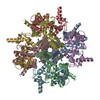 8j00C 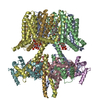 8j01C 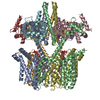 8j02C 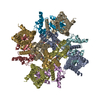 8j03C 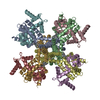 8j04C 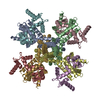 8j05C 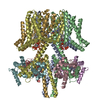 8w4uC M: atomic model generated by this map C: citing same article ( |
|---|---|
| Similar structure data | Similarity search - Function & homology  F&H Search F&H Search |
- Links
Links
| EMDB pages |  EMDB (EBI/PDBe) / EMDB (EBI/PDBe) /  EMDataResource EMDataResource |
|---|---|
| Related items in Molecule of the Month |
- Map
Map
| File |  Download / File: emd_35877.map.gz / Format: CCP4 / Size: 52.7 MB / Type: IMAGE STORED AS FLOATING POINT NUMBER (4 BYTES) Download / File: emd_35877.map.gz / Format: CCP4 / Size: 52.7 MB / Type: IMAGE STORED AS FLOATING POINT NUMBER (4 BYTES) | ||||||||||||||||||||
|---|---|---|---|---|---|---|---|---|---|---|---|---|---|---|---|---|---|---|---|---|---|
| Voxel size | X=Y=Z: 1.014 Å | ||||||||||||||||||||
| Density |
| ||||||||||||||||||||
| Symmetry | Space group: 1 | ||||||||||||||||||||
| Details | EMDB XML:
|
-Supplemental data
-Half map: #2
| File | emd_35877_half_map_1.map | ||||||||||||
|---|---|---|---|---|---|---|---|---|---|---|---|---|---|
| Projections & Slices |
| ||||||||||||
| Density Histograms |
-Half map: #1
| File | emd_35877_half_map_2.map | ||||||||||||
|---|---|---|---|---|---|---|---|---|---|---|---|---|---|
| Projections & Slices |
| ||||||||||||
| Density Histograms |
- Sample components
Sample components
-Entire : human KCNQ2-CaM in complex with HN37
| Entire | Name: human KCNQ2-CaM in complex with HN37 |
|---|---|
| Components |
|
-Supramolecule #1: human KCNQ2-CaM in complex with HN37
| Supramolecule | Name: human KCNQ2-CaM in complex with HN37 / type: complex / ID: 1 / Parent: 0 / Macromolecule list: #1 |
|---|---|
| Source (natural) | Organism:   Homo sapiens (human) Homo sapiens (human) |
-Macromolecule #1: Potassium voltage-gated channel subfamily KQT member 2
| Macromolecule | Name: Potassium voltage-gated channel subfamily KQT member 2 type: protein_or_peptide / ID: 1 / Number of copies: 4 / Enantiomer: LEVO |
|---|---|
| Source (natural) | Organism:   Homo sapiens (human) Homo sapiens (human) |
| Molecular weight | Theoretical: 73.627812 KDa |
| Recombinant expression | Organism:   Homo sapiens (human) Homo sapiens (human) |
| Sequence | String: MAGKPPKRNA FYRKLQNFLY NVLERPRGWA FIYHAYVFLL VFSCLVLSVF STIKEYEKSS EGALYILEIV TIVVFGVEYF VRIWAAGCC CRYRGWRGRL KFARKPFCVI DIMVLIASIA VLAAGSQGNV FATSALRSLR FLQILRMIRM DRRGGTWKLL G SVVYAHSK ...String: MAGKPPKRNA FYRKLQNFLY NVLERPRGWA FIYHAYVFLL VFSCLVLSVF STIKEYEKSS EGALYILEIV TIVVFGVEYF VRIWAAGCC CRYRGWRGRL KFARKPFCVI DIMVLIASIA VLAAGSQGNV FATSALRSLR FLQILRMIRM DRRGGTWKLL G SVVYAHSK ELVTAWYIGF LCLILASFLV YLAEKGENDH FDTYADALWW GLITLTTIGY GDKYPQTWNG RLLAATFTLI GV SFFALPA GILGSGFALK VQEQHRQKHF EKRRNPAAGL IQSAWRFYAT NLSRTDLHST WQYYERTVTV PMYSSQTQTY GAS RLIPPL NQLELLRNLK SKSGLAFRKD PPPEPSPSKG SPCRGPLCGC CPGRSSQKVS LKDRVFSSPR GVAAKGKGSP QAQT VRRSP SADQSLEDSP SKVPKSWSFG DRSRARQAFR IKGAASRQNS EEASLPGEDI VDDKSCPCEF VTEDLTPGLK VSIRA VCVM RFLVSKRKFK ESLRPYDVMD VIEQYSAGHL DMLSRIKSLQ SRVDQIVGRG PAITDKDRTK GPAEAELPED PSMMGR LGK VEKQVLSMEK KLDFLVNIYM QRMGIPPTET EAYFGAKEPE PAPPYHSPED SREHVDRHGC IVKIVRSSSS TGQKNFS VE GGSSGGWSHP QFEK UniProtKB: Potassium voltage-gated channel subfamily KQT member 2 |
-Macromolecule #2: methyl N-[4-[(4-fluorophenyl)methyl-prop-2-ynyl-amino]-2,6-dimeth...
| Macromolecule | Name: methyl N-[4-[(4-fluorophenyl)methyl-prop-2-ynyl-amino]-2,6-dimethyl-phenyl]carbamate type: ligand / ID: 2 / Number of copies: 8 / Formula: 9MF |
|---|---|
| Molecular weight | Theoretical: 340.391 Da |
| Chemical component information | 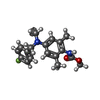 ChemComp-9MF: |
-Experimental details
-Structure determination
| Method |  cryo EM cryo EM |
|---|---|
 Processing Processing |  single particle reconstruction single particle reconstruction |
| Aggregation state | particle |
- Sample preparation
Sample preparation
| Buffer | pH: 8 |
|---|---|
| Vitrification | Cryogen name: ETHANE |
- Electron microscopy
Electron microscopy
| Microscope | FEI TITAN KRIOS |
|---|---|
| Electron beam | Acceleration voltage: 300 kV / Electron source:  FIELD EMISSION GUN FIELD EMISSION GUN |
| Electron optics | Illumination mode: FLOOD BEAM / Imaging mode: BRIGHT FIELD Bright-field microscopy / Nominal defocus max: 1.3 µm / Nominal defocus min: 1.1 µm Bright-field microscopy / Nominal defocus max: 1.3 µm / Nominal defocus min: 1.1 µm |
| Image recording | Film or detector model: GATAN K2 SUMMIT (4k x 4k) / Average electron dose: 64.0 e/Å2 |
| Experimental equipment |  Model: Titan Krios / Image courtesy: FEI Company |
- Image processing
Image processing
| Startup model | Type of model: PDB ENTRY PDB model - PDB ID: |
|---|---|
| Initial angle assignment | Type: MAXIMUM LIKELIHOOD |
| Final angle assignment | Type: MAXIMUM LIKELIHOOD |
| Final reconstruction | Resolution.type: BY AUTHOR / Resolution: 2.5 Å / Resolution method: FSC 0.143 CUT-OFF / Number images used: 367290 |
 Movie
Movie Controller
Controller



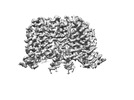








 Z
Z Y
Y X
X


















